Void-Engineered Metamaterial Delay Line with Built-In Impedance Matching for Ultrasonic Applications
Abstract
:1. Introduction
2. Metamaterial Fabrication
3. Theoretical and Empirical Analyses for the Design of the Metamaterial DL
3.1. Impedance Measurement
3.2. Theoretical Verification of the Measured Impedances
3.3. Design of the Metamaterial Delay Line
4. Experimental Validation
4.1. Experimental Setup
4.2. Results and Discussions
5. Summary, Conclusions, and Future Work
- Acoustic DL samples with different, and graded, void ratios were successfully fabricated using additive manufacturing.
- The relationship between the void ratio and acoustic impedance was characterized, resulting in a metamaterial DL being designed and fabricated to achieve impedance matching both at the sensor and target interfaces.
- The experimental results, which are supported by the theoretical analysis, show the metamaterial DL has a 120% increased energy transmission and more than two-fold reduced standing wave ratio compared to the standard commercial DL; this enables its significantly improved damage detection capability.
- Our work establishes a promising pathway to control acoustic properties using practical metamaterials, which are fabricated using common additive manufacturing techniques, including achieving properties not readily available using natural materials.
Author Contributions
Funding
Institutional Review Board Statement
Informed Consent Statement
Data Availability Statement
Conflicts of Interest
References
- Cheeke, J.D.; Zagzebski, J. Fundamentals and Applications of Ultrasonic Waves. Am. J. Phys. 2004, 72, 719. [Google Scholar] [CrossRef]
- Palanisamy, R.P.; Karpenko, O.; Vattathurvalappil, S.H.; Deng, Y.; Udpa, L.; Haq, M. Guided wave monitoring of Nano-Fe3O4 reinforced thermoplastic adhesive in manufacturing of reversible composite lap-joints using targeted electromagnetic heating. NDT E Int. 2021, 122, 102481. [Google Scholar] [CrossRef]
- Palanisamy, R.P.; Banerjee, P.; Haq, M.; Deng, Y. Diagnosis and Prognosis of Fatigue Damage in Adhesively Bonded Joints Using Ultrasound Non-Destructive Evaluation. J. Nondestruct. Eval. Diagnostics Progn. Eng. Syst. 2022, 5, 041008. [Google Scholar] [CrossRef]
- Kažys, R.; Rekuviene, R.; Žukauskas, E. Numerical investigation of ultrasonic wave propagation in tapered waveguides. Elektron. Ir Elektrotechnika 2013, 19, 55–58. [Google Scholar] [CrossRef]
- Kazys, R.; Zukauskas, E.; Rekuviene, R. Modeling of ultrasonic measurement systems with waveguides. Elektron. Ir Elektrotechnika 2012, 123, 61–64. [Google Scholar] [CrossRef]
- Ono, Y.; Jen, C.K.; Moisan, J.F.; Zhang, Y.; Su, C.Y.; Zhang, Y. Aluminum Buffer Rods for Ultrasonic Monitoring at Elevated Temperatures. IEEE Trans. Ultrason. Ferroelectr. Freq. Control 2005, 52, 1044–1049. [Google Scholar] [CrossRef]
- Li, Z.; Yang, D.Q.; Liu, S.L.; Yu, S.Y.; Lu, M.H.; Zhu, J.; Zhang, S.T.; Zhu, M.W.; Guo, X.S.; Wu, H.D.; et al. Broadband gradient impedance matching using an acoustic metamaterial for ultrasonic transducers. Sci. Rep. 2017, 7, 42863. [Google Scholar] [CrossRef]
- Kelly, S.P.; Hayward, G.; Gomez, T.E. An air-coupled ultrasonic matching layer employing half wavelength cavity resonance. In Proceedings of the 2001 IEEE Ultrasonics Symposium. Proceedings. An International Symposium (Cat. No.01CH37263), Atlanta, GA, USA, 7–10 October 2001; Volume 2, pp. 965–968. [Google Scholar] [CrossRef]
- Rathod, V.T. A review of acoustic impedance matching techniques for piezoelectric sensors and transducers. Sensors 2020, 20, 4051. [Google Scholar] [CrossRef]
- Cummer, S.A.; Christensen, J.; Alù, A. Controlling sound with acoustic metamaterials. Nat. Rev. Mater. 2016, 1, 16001. [Google Scholar] [CrossRef]
- Shelby, R.A.; Smith, D.R.; Schultz, S. Experimental verification of a negative index of refraction. Science 2001, 292, 77–79. [Google Scholar] [CrossRef]
- Lee, D.; Nguyen, D.M.; Rho, J. Acoustic wave science realized by metamaterials. Nano Converg. 2017, 4, 3. [Google Scholar] [CrossRef]
- Li, J.; Fok, L.; Yin, X.; Bartal, G.; Zhang, X. Experimental demonstration of an acoustic magnifying hyperlens. Nat. Mater. 2009, 8, 931–934. [Google Scholar] [CrossRef]
- Im, K.; Park, Q.H. Omni-directional and broadband acoustic anti-reflection and universal acoustic impedance matching. Nanophotonics 2022, 11, 2191–2198. [Google Scholar] [CrossRef]
- Fan, J.; Zhang, L.; Wang, X.; Zhang, Z.; Wei, S.; Song, B.; Zhao, A.; Xiang, X.; Zhu, X.; Shi, Y. 3D Printed Ultra-thin Acoustic Metamaterials with Adaptable Low-frequency Absorption Performance. Chinese J. Mech. Eng. Addit. Manuf. Front. 2022, 1, 100036. [Google Scholar] [CrossRef]
- Gao, S.; Liu, W.; Zhang, L.; Gain, A.K. A new polymer-based mechanical metamaterial with tailorable large negative Poisson’s ratios. Polymers 2020, 12, 1492. [Google Scholar] [CrossRef]
- Xie, Y.; Konneker, A.; Popa, B.I.; Cummer, S.A. Tapered labyrinthine acoustic metamaterials for broadband impedance matching. Appl. Phys. Lett. 2013, 103, 201906. [Google Scholar] [CrossRef]
- Zhu, X.; Li, K.; Zhang, P.; Zhu, J.; Zhang, J.; Tian, C.; Liu, S. Implementation of dispersion-free slow acoustic wave propagation and phase engineering with helical-structured metamaterials. Nat. Commun. 2016, 7, 11731. [Google Scholar] [CrossRef] [PubMed]
- Li, L.; Diao, Y.; Wu, H.; Jiang, W. Complementary Acoustic Metamaterial for Penetrating Aberration Layers. ACS Appl. Mater. Interfaces 2022, 14, 28604–28614. [Google Scholar] [CrossRef] [PubMed]
- Wong, C.M.; Chan, S.F.; Wu, W.C.; Suen, C.H.; Yau, H.M.; Wang, D.Y.; Li, S.; Dai, J.Y. Tunable high acoustic impedance alumina epoxy composite matching for high frequency ultrasound transducer. Ultrasonics 2021, 116, 106506. [Google Scholar] [CrossRef] [PubMed]
- Zhu, K.; Ma, J.; Qi, X.; Shen, B.; Liu, Y.; Sun, E.; Zhang, R. Enhancement of Ultrasonic Transducer Bandwidth by Acoustic Impedance Gradient Matching Layer. Sensors 2022, 22, 8025. [Google Scholar] [CrossRef] [PubMed]
- Bian, J.; Wang, Y.; Liu, Z.; Shen, M.; Zhao, H.; Sun, Y.; Zhu, J. Ultra-wideband underwater acoustic transducer with a gradient impedance matching layer. Appl. Acoust. 2021, 175, 107789. [Google Scholar] [CrossRef]
- Shokrieh, M.M.; Moshrefzadeh-Sani, H. On the constant parameters of Halpin-Tsai equation. Polymer 2016, 106, 14–20. [Google Scholar] [CrossRef]
- Patterson, W.; Force, A. The Halpin-Tsai Equations: A Review. Polym. Eng. Sci. 1976, 16, 344–352. [Google Scholar]
- Shanmugasundaram, S.A.; Razmi, J.; Mian, M.J.; Ladani, L. Mechanical anisotropy and surface roughness in additively manufactured parts fabricated by stereolithography (SLA) using statistical analysis. Materials 2020, 13, 2496. [Google Scholar] [CrossRef]
- The Ultran Group (n.d.). Available online: https://ultrangroup.com/products/transducers/vlf/delayed-contact/ (accessed on 10 August 2023).
- Bhattacharjee, A.; Terry Loghmani, M.; Anwar, S. Finite Element Simulation and Analysis of Drop Tests To Improve the Mechanical Design of a Handheld Qstm Medical Device. In Proceedings of the ASME International Mechanical Engineering Congress and Exposition, Proceedings (IMECE), Columbus, OH, USA, 30 October–3 November 2022; Volume 4. [Google Scholar] [CrossRef]
- Form Labs. (n.d.). Available online: https://formlabs.com/materials/rigid/ (accessed on 12 August 2023).
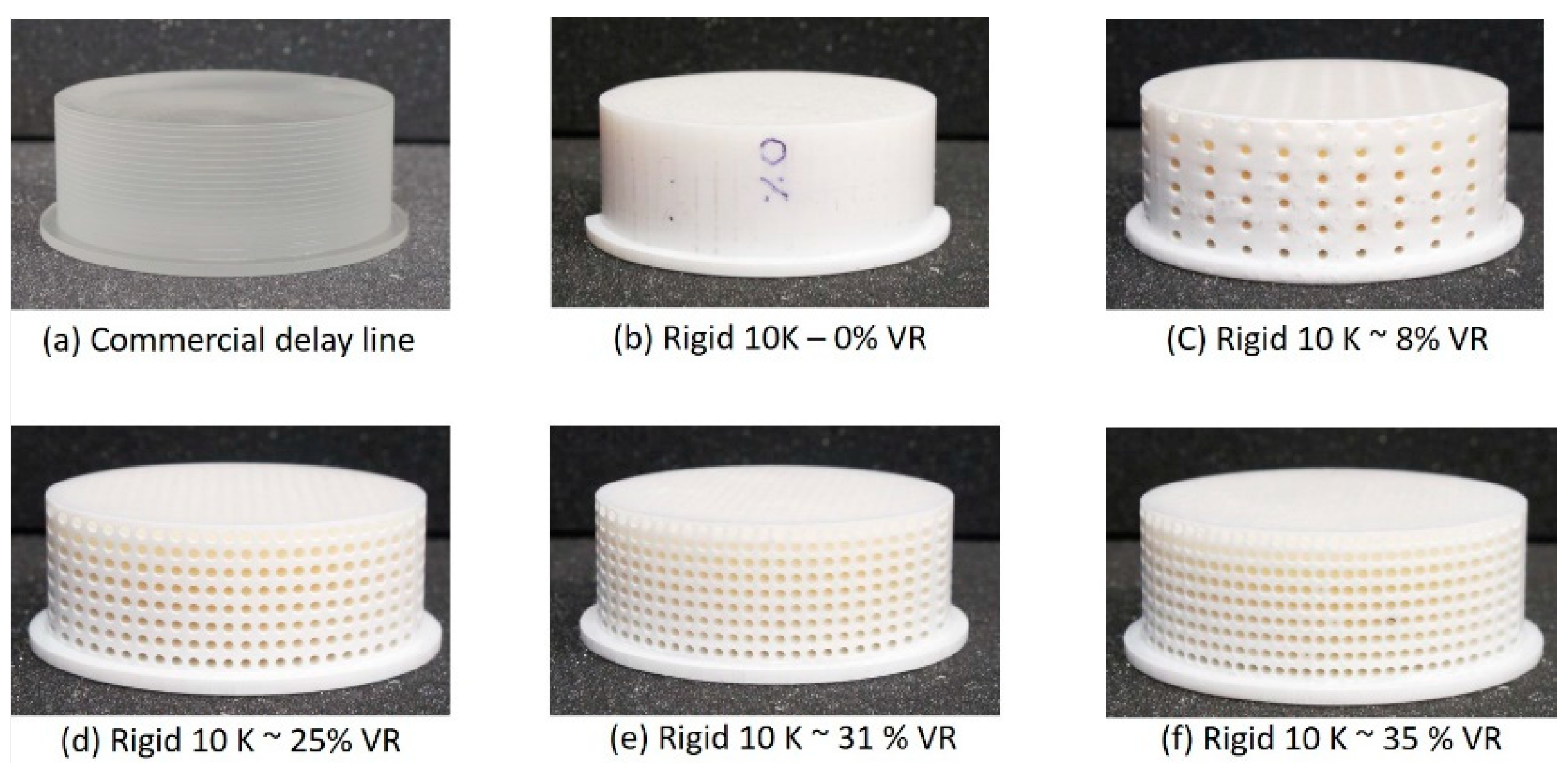
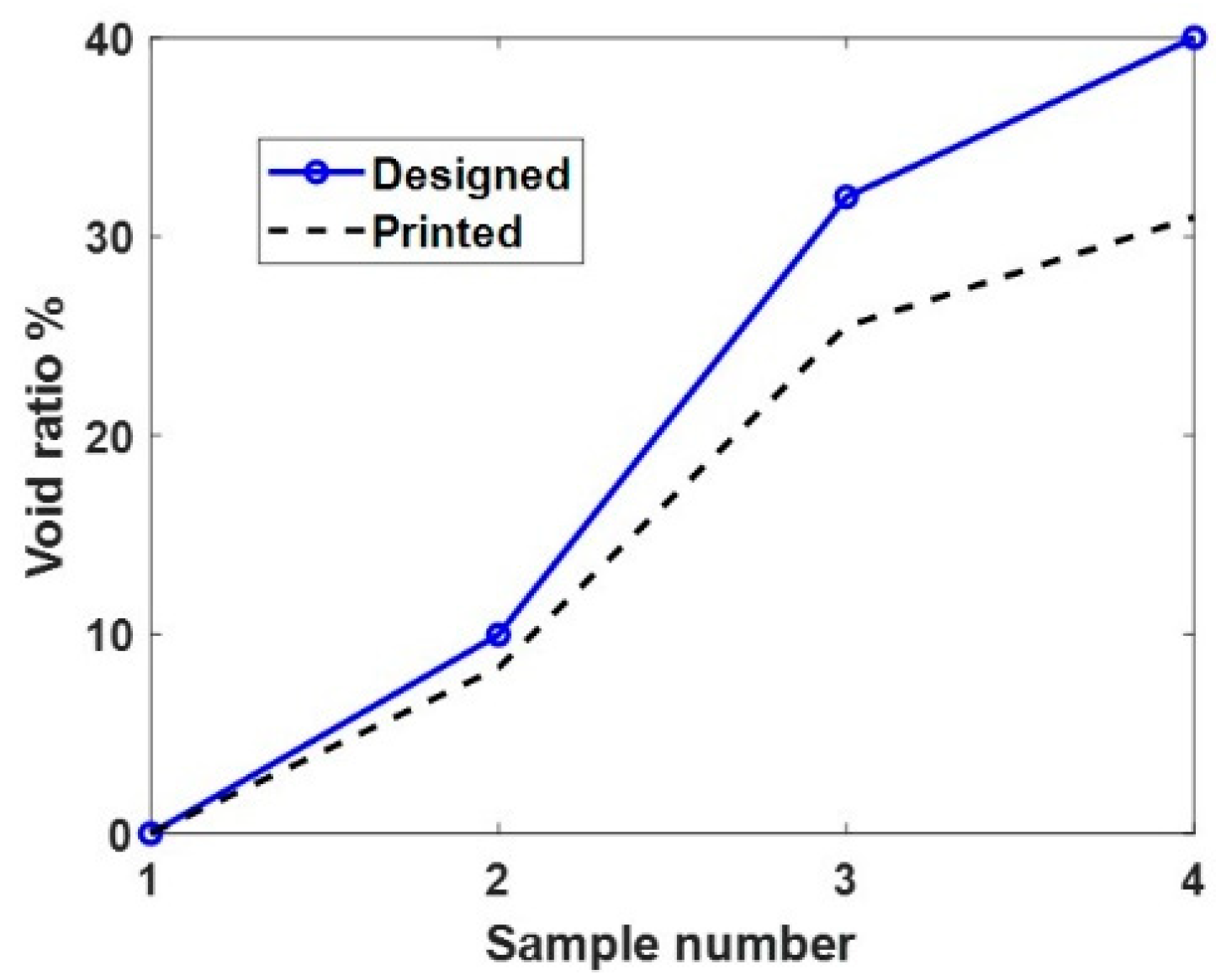

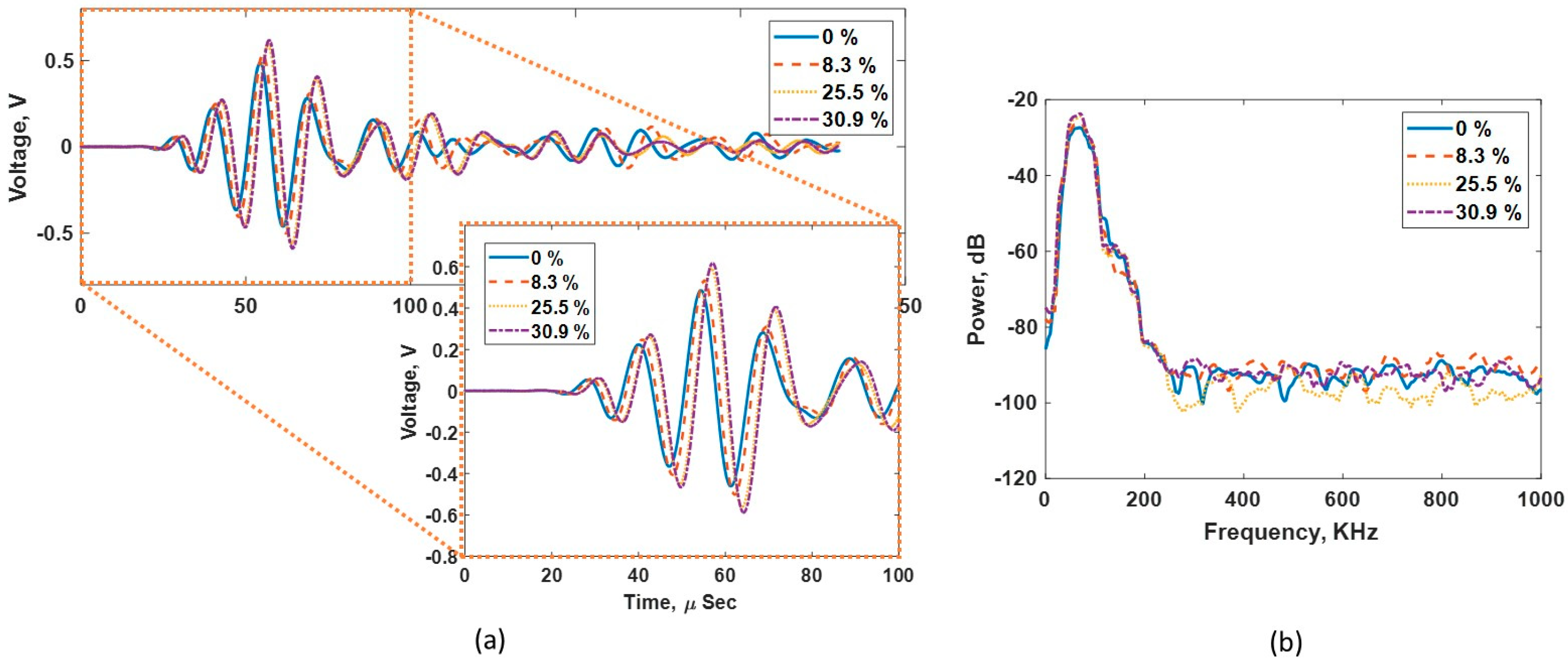
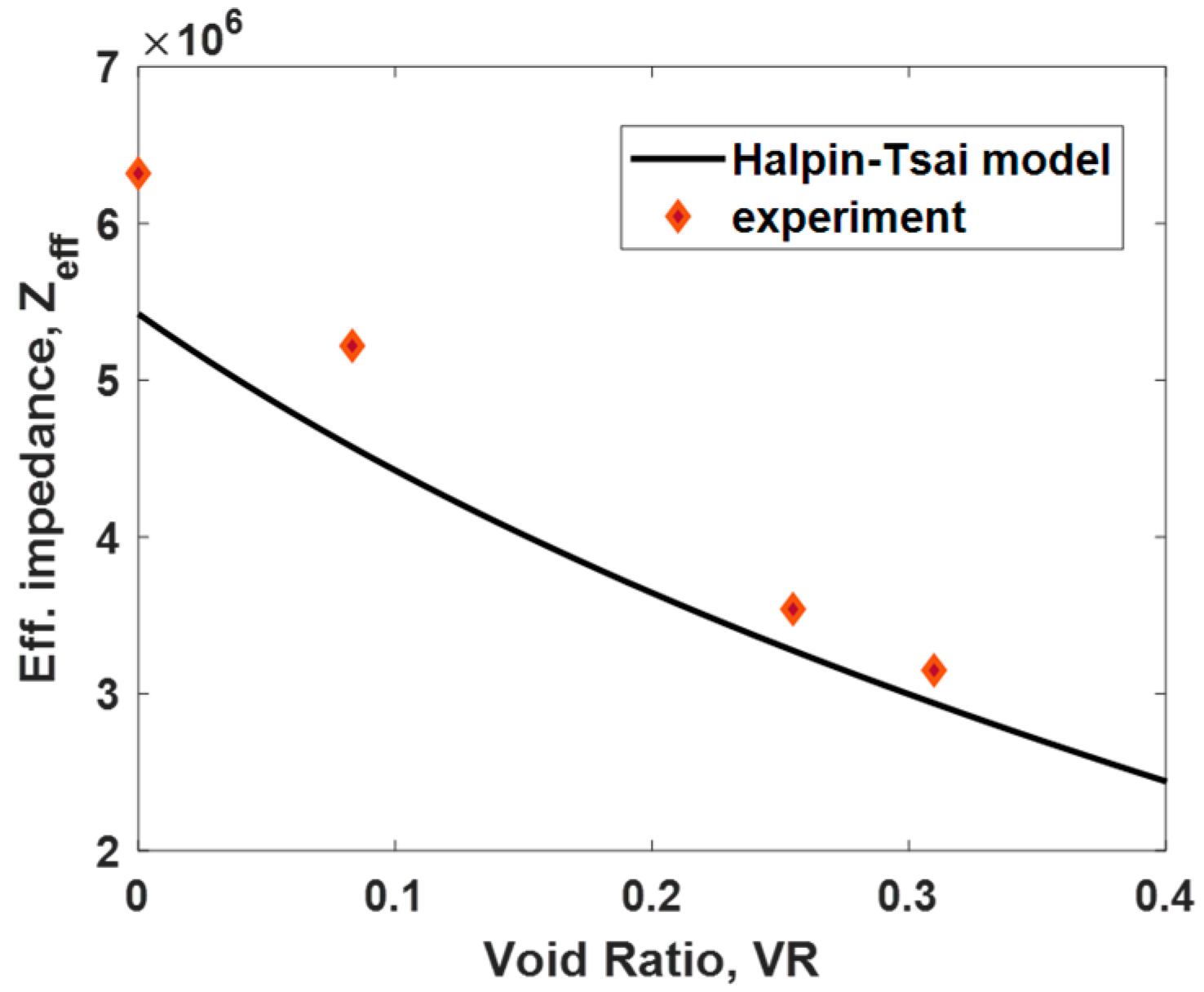
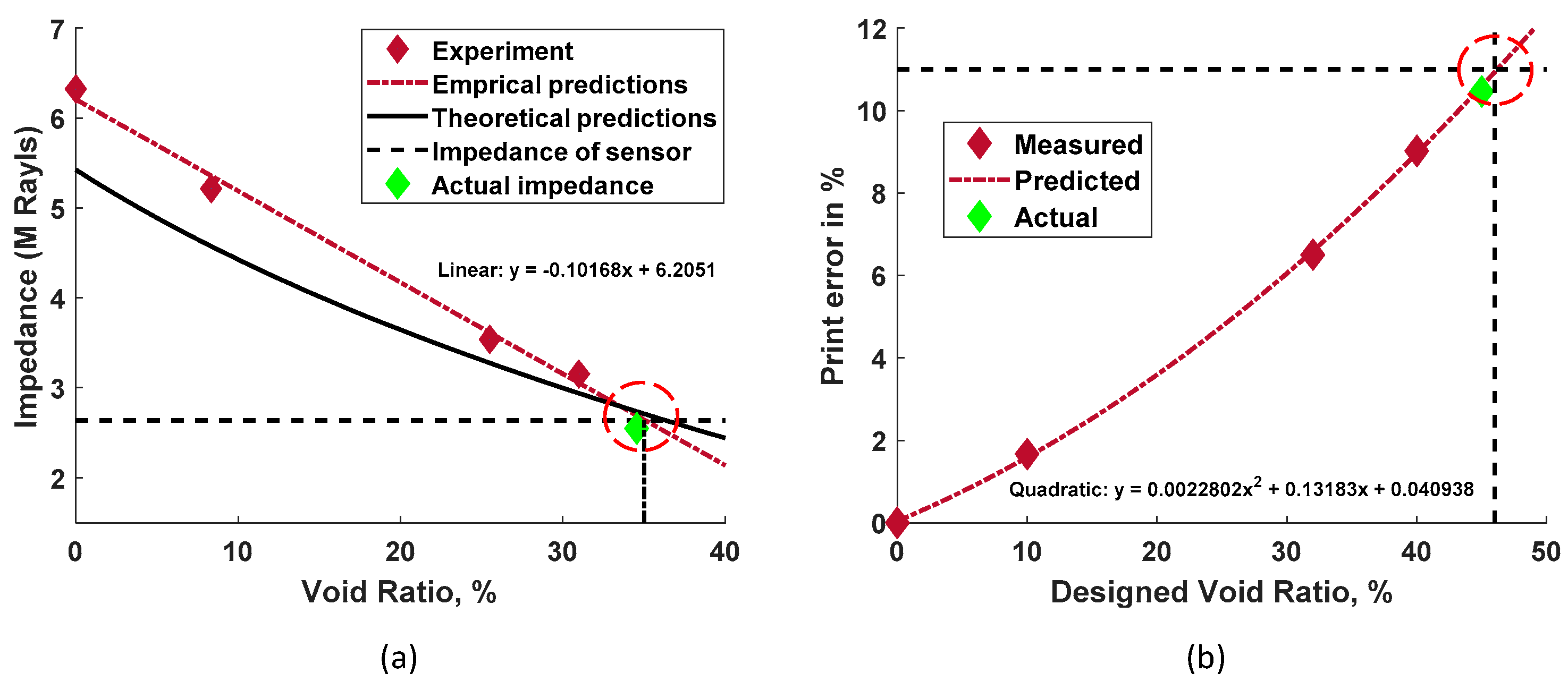

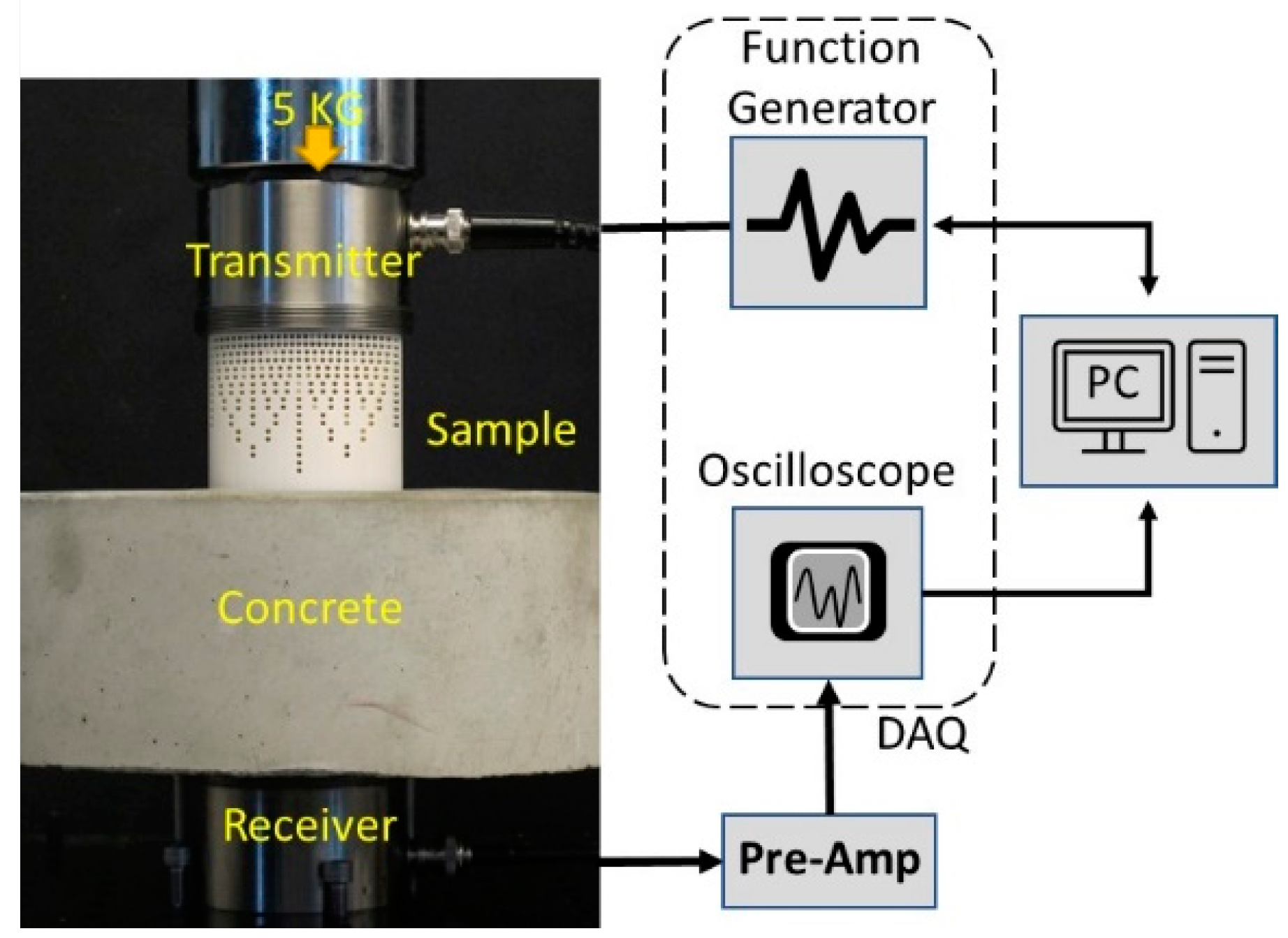
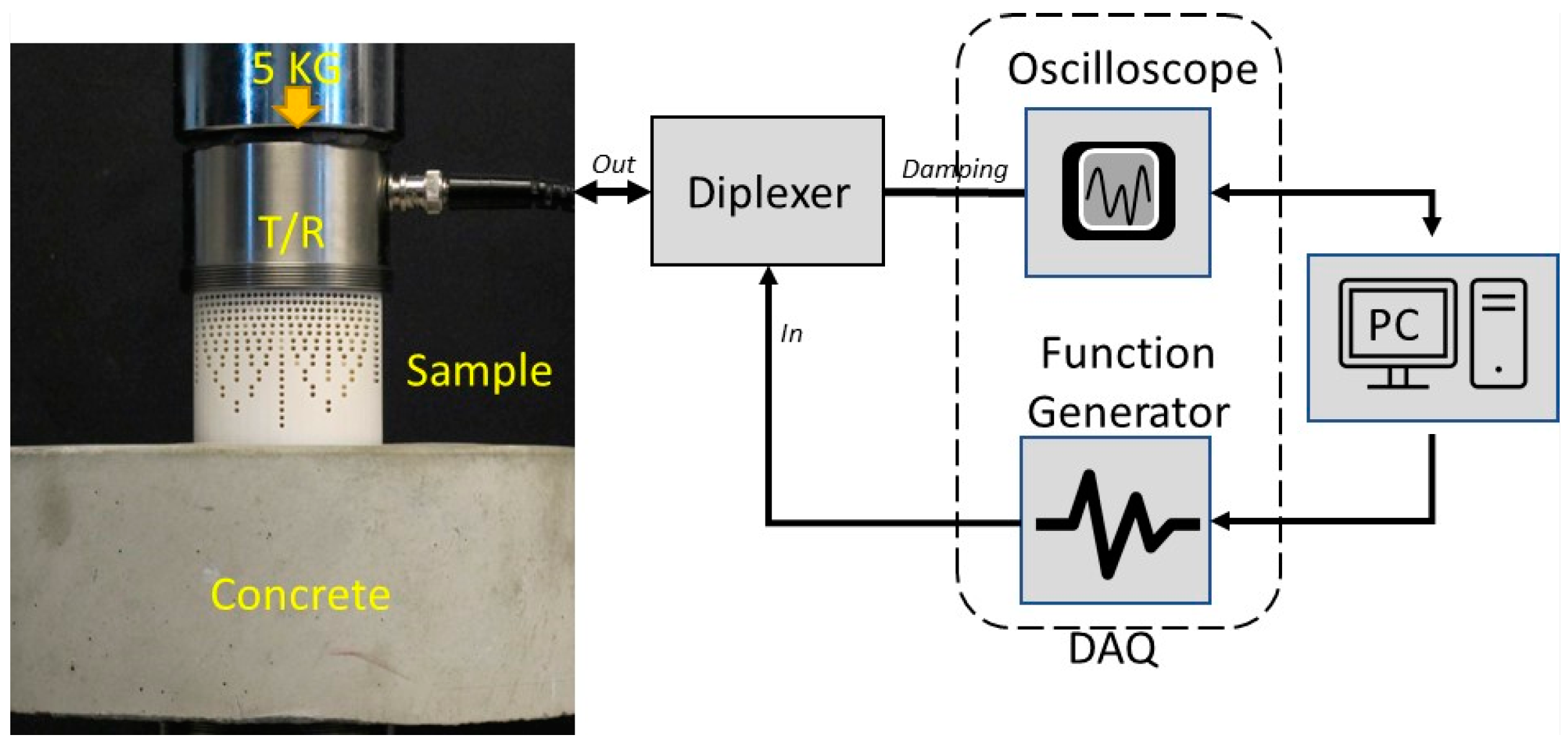



| Samples | Designed VR (%) | Printed VR (%) | Weight (g) | (Kg/M3) | Velocity, V (M/s) | Impedance, Z (MRayl) |
|---|---|---|---|---|---|---|
| Commercial Delay line | - | - | 85.7 | 1070 | 2473 | 2.64 |
| 1 | 0 | 0 | 140.4 | 1750 | 3616 | 6.32 |
| 2 | 10 | 8.33 | 128.7 | 1600 | 3254 | 5.22 |
| 3 | 32 | 25.49 | 104.6 | 1300 | 2717 | 3.54 |
| 4 | 40 | 30.98 | 96.9 | 1200 | 2613 | 3.15 |
| 5 | 45 | 34.54 | 91.9 | 1140 | 2231 | 2.55 |
| Material Properties | Void Filler (Air) | Matrix (Cured Rigid 10k Resin) |
|---|---|---|
| Elastic modulus (E) | 0 GPA | 10 GPA |
| Poisson’s ratio () | 0 | 0.36 |
| Density () | 1.293 kg/m3 | 1750 kg/m3 |
Disclaimer/Publisher’s Note: The statements, opinions and data contained in all publications are solely those of the individual author(s) and contributor(s) and not of MDPI and/or the editor(s). MDPI and/or the editor(s) disclaim responsibility for any injury to people or property resulting from any ideas, methods, instructions or products referred to in the content. |
© 2024 by the authors. Licensee MDPI, Basel, Switzerland. This article is an open access article distributed under the terms and conditions of the Creative Commons Attribution (CC BY) license (https://creativecommons.org/licenses/by/4.0/).
Share and Cite
Palanisamy, R.P.; Chavez, L.A.; Castro, R.; Findikoglu, A.T. Void-Engineered Metamaterial Delay Line with Built-In Impedance Matching for Ultrasonic Applications. Sensors 2024, 24, 995. https://doi.org/10.3390/s24030995
Palanisamy RP, Chavez LA, Castro R, Findikoglu AT. Void-Engineered Metamaterial Delay Line with Built-In Impedance Matching for Ultrasonic Applications. Sensors. 2024; 24(3):995. https://doi.org/10.3390/s24030995
Chicago/Turabian StylePalanisamy, Rajendra P., Luis A. Chavez, Raymond Castro, and Alp T. Findikoglu. 2024. "Void-Engineered Metamaterial Delay Line with Built-In Impedance Matching for Ultrasonic Applications" Sensors 24, no. 3: 995. https://doi.org/10.3390/s24030995






